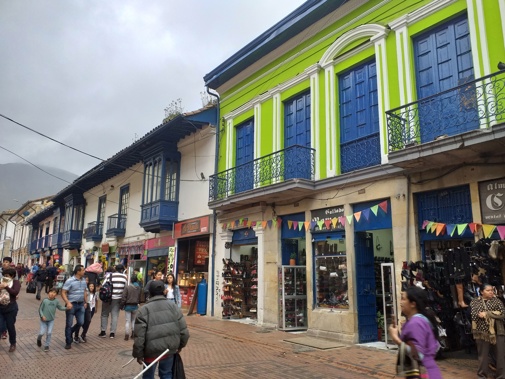
It was my first foray to Colombia’s bustling cradle of Bogota, the third-highest capital in the world. When I mentioned to friends that I was Colombia-bound, they reflexively questioned, “Is it safe?” The country’s war-torn, blood-stained, drug-fuelled back-story needs little introduction. Compared to the ‘80s and 90s, it is infinitely safer today. The risk of kidnapping or guerrilla-inspired violence is negligible compared to its darker days, and a street-savvy traveller who keeps their wits about them is most unlikely to be mugged. Truth be told, at no stage in Colombia did I ever feel unsafe. Yes, there are certain parts of Bogota that are best avoided, still plagued with street robberies and drug-fuelled violence.
Your hotel and local guides will happily point out where’s best to give the wide berth to, or to be extra-vigilant. And after dark, I was ultra-careful to keep my possessions under wraps. Don’t flash and flaunt your latest iPhone as you walk about. Take a photo and promptly return it to your pocket. Exercise some basic safety smarts and Colombia will sweep you up in its charismatic embrace. After hauling my way across the Pacific to Bogota, via Houston, my charming Viva Expeditions guide, Daniel, warmly greeted me at the airport, before I recharged my sleep-deprived batteries at the gorgeous little boutique hotel, De La Opera.
One of the historic centre’s poshest locales, Hotel De La Opera, was named in honour of the leotard shows at Teatro Colon next door. It features sublimely restored guestrooms, incorporating two historic Spanish colonial townhouses, that form a gorgeous central courtyard, where breakfast, lunch and dinner is served. Boutique, character-laden hotels are all the rage in Colombia and this is a stirring specimen! www.hotelopera.com.co
Feeling suitably rested and freshly fortified on flavourful Colombian tinto coffee, La Candelaria was itching to be explored, a potpourri of preciously restored colonial gems, 300 year old houses, museums, eateries and churches. Food vendors do a brisk trade from their colourful street stalls, while llamas are paraded through and street bands play, all adding to the insta-friendly spectacle. Nestled below the serrated backdrop of chilly Andean peaks, the city’s historic colonial barrio is not the place to rush about, given its high-altitude. Start to feel dizzy? Slow down and take some deep breaths. Crowning Monserrate peak, at 3152m, is the city’s sky-high symbol, the white-stone church, which has had many miracles attributed to it. It’s a 1500-step hike to the top, or take the funicular.
Blissfully alive and chock full of attractions, La Candelaria is where Bogota was born. Just a block back from my hotel, the self-important sweeping grandeur of Plaza de Bolivar struck me as Bogota’s picture-perfect living room, underpinned with so much history, turmoil and bloodshed. I gazed across the stately Palace of Justice, where 300 civilians were taken hostage by M-19 guerrillas in 1985. 24 hours later, 115 people were dead, including 11 Supreme Court judges, as the army sought to bring the offensive to a close. Later that night, in a sign of Colombia’s ongoing political tensions, a monstrous peace rally was staged to protest the mysterious mass-killings of social justice campaigners across Colombia.
Taking pride of place in the plaza’s heart, a massive bronze statue of Simon Bolivar, the region’s great liberator, who unshackled Colombia and its neighbours from the shackles of Spanish rule. Standing on the site of where Bogota’s first mass was apparently celebrated in 1538, the neo-classical might of Catedral Primada lords over the plaza. Quesada, the Spanish founder of Bogota, is buried inside the church, which has relatively little ornamentation. If lavish church interiors, there’s plenty of other eye-catching specimens in the vicinity, including Capilla del Sagrario.
For a gritty taste of Colombia’s past troubles, the Museo Historico Policia has a compelling exhibition tracing the demise of Pablo Escobar in 1993 – complete with model dummy of his bullet-ridden corpse, his personal Bernadelli pocket pistol and his Harley Davidson.
But amid the sheer gluttony of Bogota museums, the glittering jewel to beat them all is Museo del Oro, one of South America’s most revered galleries. Boasting more than 55,000 pieces of gold from the major pre-Hispanic cultures in Colombia, the museum is thoughtfully laid-out in thematic rooms, providing fascinating insights into how gold was so liberally used by indigenous tribes as ritual offerings. Just north of the city, Lake Guatavita, is famed for the sheer volume of gold offerings deposited in its waters by pre-Hispanic tribes.
In this burgeoning metropolis of 8 million, the gaping absence of an underground metro system sticks in the craw of many a local. Traffic jams are a constant menace, navigating your way around the city. Daniel, my fabulous Bogota guide, frequently unleashed a red-blooded rant about how corrupt politicians have continued to drag the chain on making metro rail in a reality. I spent a lot of time absorbing the traffic crush, while hop-scotching my way across the city to ogle Bogota’s radiant parade of urban graffiti murals.
Eight years ago, after the police killed a 16 year-old tagger, immense protests erupted throughout the city. The uproar played a part in the government taking a much more permissive line on graffiti, whereby many public sites are now legitimate urban canvases for street art, alongside the ugly scrawl of illegal graffiti, which can still attract you a night in police detention and a fine. Bogota’s street art strikingly reflects its diverse and tumultuous personality. Confronting anti-capitalist imagery is a recurring theme, as are motifs centred on feminism, poverty, violence and the environment. It’s like an open-air exhibition of left-wing artistic expression.
But regardless of your political persuasions, the scale, colour, detailing and sheer artistic gall is visually compelling. Take a Bogota graffiti tour to size up the dizzying array of wall and building murals, that are redefining the streetscape every day. Apparently, Bogota has 8000 street artists. Despite Bogota’s burgeoning middle-class, class differences are still very much apparent, with the wealthy, modern northern section a world away from the crime-infested slums of the city’s southern barrios.
Another unforgettable and authentic cultural highlight in Bogota was my visit to a Tejo bar. Daniel escorted me to Club De Tejo La 76, which was humming with Bogatanos on a Friday night, downing beers in a room full of live explosives. Fondly referred to as Colombia’s national sport, locals get together to drink heavily and then throw metal pucks at triangle-shaped explosives made from gunpowder. Long corridors lead to a board set up at a 45 degree angle. Covered with clay, so that the puck (or tejo) doesn’t bounce out and hit someone, the idea is to hit the triangle-shaped envelopes adjoining a metal pipe, (mechas) packed with gunpowder. The winning team is the one who clocks up the highest number of explosive strikes. As a pyrotechnic from way back, it’s addictively good fun! Out the front, the tejo lounge food was as a cheap as chips. A plate of sausage, ribs, yucca, plantain and potatoes, along with two beers, cost a mere NZ$7.
My fabulous foray to Bogota and Colombia was with Viva Expeditions, who operate a wealth of touring options across South America, with outstanding on-the-ground expertise and support, ensuring your South American adventure is seamless, stress-free and full of magic. Their handpicked
team of local guides and tour operators will ensure you’re immersed in the spirit and wonder of Colombia. www.vivaexpeditions.com
Getting there? Given Colombia’s position at the top-end of South America, I opted to fly via the United States to Bogota, first flying non-stop to San Francisco from Auckland with United Airlines. The conveniently timed overnight flight helped lull me into snooze mode across the Pacific, before catching a connecting flight to Houston and on to Bogota. United offers a staggering network of destinations and connectivity. For ultimate lie-flat indulgence, fly in Polaris Class, offering excellent privacy in a staggered 1-2-1 configuration, with recessed space for feet, a console, small cupboard for water, amenity kits and headphones and generously-sized touch-screen TV, and two windows. Premium Plus is United’s new and improved Premium Economy offering. The seats are designed to be more comfortable than those in Economy, with extended recline and definitely more room for legs and elbows.
You also get Saks Fifth Avenue bedding (a pillow and soft, woollen blanket) and slippers, and an amenity kit with socks, eye mask, ear plugs, dental kit and Sunday Riley hand cream and lip balm. Along with a 13-inch seatback touchscreen and noise cancelling headphones, premium passengers get an enhanced food selection too, elegantly served on proper plates with metal cutlery and linen napkins. Whatever class of travel you choose, United serves up a vast library of movie, TV, audio and games channels available to watch on the seatback TVs or on personal devices using the United app. Plus you can order up United wifi on many flights. www.united.com
Mike Yardley is our Travel Correspondent on Jack Saturday Mornings
Take your Radio, Podcasts and Music with you









